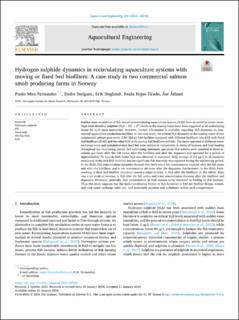| dc.description.abstract | Sudden mass mortalities of fish reared in recirculating aquaculture systems (RAS) have occurred in recent years. High total dissolved sulphide (H2S + HS- + S2-) levels in the rearing water have been suggested as an underlaying factor for such mass mortalities. However, limited information is available regarding H2S dynamics in commercial aquaculture production facilities. In this case study, we present H2S dynamics in the rearing water of two commercial salmon post-smolt (150–250 g) RAS facilities equipped with different biofilters: one RAS with fixed bed biofilters (fRAS) and the other RAS with moving bed biofilters (mRAS). The farms operated at different water exchange rates and cumulative feed load but were otherwise comparable in terms of biomass and feed loading throughout the monitoring period. Self-calibrating, automatic gas-phase H2S sensors were installed at three locations per farm: after the fish tanks, after the biofilters and after the degassers and operated for a period of approximately 70 days in both farms. H2S was observed at maximum daily average of 0.6 µg/L in all locations monitored in the two RAS facilities and no significant fish mortality was reported during the monitoring period. In the fRAS, H2S concentration dynamics showed that there was a net concentration increase after the fish tanks and after the biofilters, and a net concentration decrease after the degassers. Furthermore, in the fRAS, backwashing of fixed bed biofilter chambers caused a slight increase in H2S after the biofilters. In the mRAS, there was a net positive increase in H2S after the fish tanks, and a net concentration decrease after the biofilters and degassers. Moreover, generally, H2S concentration in RAS seemed to be unrelated to feeding or fish biomass. Thus, this study suggests that the main contributing factors to H2S dynamics in RAS are biofilter design, system, and tank water exchange rates and, and potentially aeration and turbulence within each compartment. | en_US |

